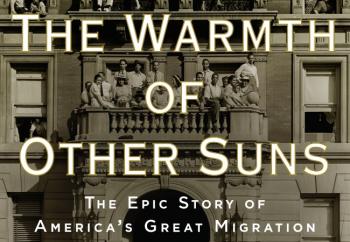
scrounge: /skrounj/ informal verb: to actively seek [books] from any available source

Book Scrounger's note: The following is a guest review by Doug, a.k.a. Professor Puzzler:
If you want to gain a better understanding of the migration of blacks from the south to the north and west during the twentieth century, while reading personal stories of those involved in the migration, I highly recommend Isabel Wilkerson's The Warmth of Other Suns.
This book can look a bit daunting for people who, when they see the word "nonfiction," expect something dry, pretentiously academic, and tedious. But this book is anything but dry; its narrative will keep your attention from start to finish. Considering the book is 538 pages long (not including acknowledgements, notes, and indices), you'll want to set aside a good block of time for it.
The book follows the lives of three migrants (and their families) from the south: Ida Mae Brandon Gladney, George Swanson Starling, and Robert Joseph Pershing Foster. Each of these people left the south for different reasons, during different decades, and for different areas of the country (Chicago, New York, and California).
Even though the stories of these three people are separated by many years, their stories are told concurrently. Thus, we read about each of the migrants' living situations in the south, then about their reasons for leaving, then their actual exodus, etc. At first glance, I thought I would have a hard time keeping the stories and people straight, because of the way the book jumps from one story to another (and because Ida Mae's husband was named George, giving us two main characters named George!), but actually there was very little confusion; the events of each subject's life were so distinctly different from the others that I had no trouble keeping track of the people involved.
In the spaces between the stories of these three migrants, Wilkerson occasionally elaborates on general conditions in the north, the south, and the west; the advancement of the Civil Rights movement, and other related subjects. She also inserts related stories from other people she interviewed, as they help support the information she provides about the broader social and political picture.
For the most part, Wilkerson is not heavy-handed in her analysis of the events; she lets the characters' stories speak for themselves. The writing style is engaging, and the events are interesting, making this a quick read (for a 500+ page history).
I have read some complaints from other reviewers that by the time she gets through the first part of the book, she begins repeating herself, and the book should have been better edited. It is true that she does occasionally repeat herself, and the sudden repetition of something you've already read can be a bit disconcerting. However, it's good to remember that when she does this, it's typically because she's referring to a "minor character" that she previously mentioned a hundred pages earlier, and she wants to make sure that we remember this person she's talking about. Perhaps there are better ways to refresh our memories than to spend a paragraph recapping what she's told us before about this person, but I considered it to be only a minor flaw in the writing.
I'd like to share one of my favorite paragraphs from the book -- a paragraph about Ida Mae Brandon Gladney:
"Many years later, people would forget about the quiet successes of everyday people like Ida Mae. In the debates to come over welfare and pathology, America would overlook people like her in its fixation with the underclass, just as a teacher can get distracted by the two or three problem children at the expense of the quiet obedient ones. Few experts trained their sights on the unseen masses of migrants like her, who worked from the moment they arrived, didn't end up on welfare, stayed married because that's what God-fearing people of their generation did whether they were happy or not, and managed to not get strung out on drugs or whiskey or a cast of nameless, no-count men."
This paragraph resonated strongly with me, because it reminds me that still today, we struggle with the same sorts of broad-sweeping generalizations; we see the very worst of a group of people, and then associate that "worst" with every member of the group, without stopping to look clearly and carefully: people who are not Christian like to look at groups like Westboro Baptist and lump all Christians with them; people who are not Muslim like to look at the worst terrorists and assume all Muslims are just like that; irresponsible, right-leaning "news" sites like to look at the worst actions perpetrated in the name of "black lives matter" and arbitrarily and illogically call the entire movement a "terrorist organization" or a "hate group."
It seems that nothing has changed.
And now I'll step down from my soapbox and say: I highly recommend reading this book, and if you have teen children who are voracious readers, and are prepared for a handful of stories of graphic violence, this book is a great educational tool. You will learn how the "Great Migration" affected the south, the north, and how it affected the lives of individual people and families along the way.
Scrounged From: Professor Puzzler's Christmas wish list
Format: Paperback
Author: Isabel Wilkerson
Pages: 622
Content Advisory: Some scenes depicting graphic violence, and several scenes demonstrating racist attitudes and actions.

